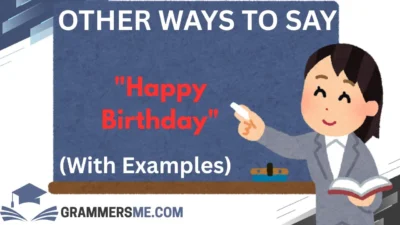Finding the right words when you’re seeking advice or assistance can make a world of difference in how your message is received. Using thoughtful, empathetic alternatives to phrases like “Please Advise” can make your communication feel more personal and considerate.
Whether you’re writing an email to a colleague, supervisor, or client, offering alternatives to “Please Advise” can help foster a more engaging and positive tone. In this article, we’ll explore 30 other ways to say “Please Advise” that will add warmth and clarity to your message, making it more meaningful and impactful.
What Does “Please Advise” Mean?
“Please Advise” is a polite and professional way of asking for guidance, suggestions, or feedback. It’s commonly used in formal and semi-formal settings to ask someone to provide their opinion or input on a matter. However, it can sound a bit too abrupt or impersonal in some situations. Finding other ways to phrase this request can improve the tone of your communication and make it sound more approachable.
Is It Professional/Polite to Say “Please Advise”?
Yes, “Please Advise” is generally considered professional and polite, especially in formal business settings. However, in some cases, it can feel overly blunt or detached. By exploring alternatives, you can still maintain professionalism while adding warmth and care to your requests, which is especially important in cultivating positive relationships with colleagues or clients.
1. Could You Kindly Share Your Thoughts?
Meaning: A respectful way to ask for someone’s opinion or feedback.
Explanation: This phrase gently invites input and shows that you value the other person’s perspective.
Scenario Example: “Could you kindly share your thoughts on the proposed project timeline?”
Best Use: Ideal for informal and semi-formal settings when you want to encourage open dialogue.
Not Use: For urgent or time-sensitive requests.
Tone: Friendly, polite, and approachable.
2. Would You Mind Offering Your Input?
Meaning: A polite request for someone’s advice or feedback.
Explanation: This phrase shows consideration for the other person’s time and thoughts.
Scenario Example: “Would you mind offering your input on the new marketing strategy?”
Best Use: Casual or semi-formal emails or meetings.
Not Use: In situations where urgency is needed.
Tone: Gentle, considerate, and respectful.
3. I Would Appreciate Your Guidance
Meaning: A formal way to express that you value someone’s expertise or advice.
Explanation: This phrase emphasizes your appreciation for the person’s wisdom.
Scenario Example: “I would appreciate your guidance on how to approach this client proposal.”
Best Use: Professional emails or when seeking expert advice.
Not Use: Casual or overly familiar communication.
Tone: Respectful and grateful.
4. Please Let Me Know What You Think
Meaning: A casual and approachable way to ask for someone’s opinion.
Explanation: This expression conveys that you are open to feedback without being overly formal.
Scenario Example: “Please let me know what you think about the draft report.”
Best Use: In casual emails or when you have an established rapport with the person.
Not Use: For very formal communication.
Tone: Friendly and approachable.
5. Could You Provide Your Insights?
Meaning: A request for someone’s expertise or knowledge on a subject.
Explanation: This phrasing implies a higher level of expertise or analysis is needed from the person.
Scenario Example: “Could you provide your insights on the best marketing channels for this product?”
Best Use: When addressing a subject that requires specific expertise or detailed feedback.
Not Use: When seeking general advice.
Tone: Respectful and professional.
6. May I Ask for Your Suggestions?
Meaning: A polite request for ideas or recommendations.
Explanation: This approach focuses on asking for ideas rather than just feedback.
Scenario Example: “May I ask for your suggestions on how to improve the team’s workflow?”
Best Use: Ideal for brainstorming sessions or when you want input on creative matters.
Not Use: In situations requiring immediate decisions.
Tone: Respectful, warm, and open.
7. I Would Love to Hear Your Opinion
Meaning: A warm and informal way to ask for someone’s thoughts or advice.
Explanation: This phrase invites feedback in a more personal and engaging way.
Scenario Example: “I would love to hear your opinion on the new design proposal.”
Best Use: For informal discussions or building stronger working relationships.
Not Use: In very formal or time-sensitive situations.
Tone: Warm, inviting, and conversational.
8. Could You Please Clarify?
Meaning: A request for more detailed or clearer information.
Explanation: This phrasing is ideal when something needs further explanation or when you’re unsure about details.
Scenario Example: “Could you please clarify your suggestions on the budget proposal?”
Best Use: When seeking clarification on specific points or instructions.
Not Use: If the person hasn’t provided any information yet.
Tone: Neutral, polite, and professional.
9. Would You Be Able to Advise Me?
Meaning: A slightly formal request for advice.
Explanation: This phrasing is a bit more formal and professional, showing that you value the person’s opinion.
Scenario Example: “Would you be able to advise me on the legal implications of this contract?”
Best Use: When requesting expert or professional advice.
Not Use: In casual conversations.
Tone: Professional, formal, and respectful.
10. Could You Help Me Understand?
Meaning: A way of asking for assistance in understanding something.
Explanation: This phrasing encourages a collaborative approach and shows that you’re open to learning.
Scenario Example: “Could you help me understand the reasoning behind the new policy?”
Best Use: In situations where clarity or deeper understanding is needed.
Not Use: When you’re simply seeking a straightforward answer.
Tone: Collaborative and respectful.
11. Can You Share Your Thoughts on This?
Meaning: An open request for feedback or suggestions.
Explanation: This phrase is less formal and invites the person to share their opinion freely.
Scenario Example: “Can you share your thoughts on the new proposal before we move forward?”
Best Use: In meetings or informal communications where feedback is encouraged.
Not Use: In urgent situations.
Tone: Friendly and approachable.
12. I Would Appreciate Your Advice on This Matter
Meaning: A formal and respectful request for advice.
Explanation: This shows appreciation for the other person’s expertise or insight.
Scenario Example: “I would appreciate your advice on the legal aspects of this agreement.”
Best Use: Formal professional requests for expert advice.
Not Use: In casual or informal contexts.
Tone: Respectful and formal.
13. What Are Your Thoughts on This?
Meaning: A direct and conversational way of asking for feedback.
Explanation: This phrase is more casual and conversational, making it ideal for informal settings.
Scenario Example: “What are your thoughts on the latest proposal I sent over?”
Best Use: Informal or semi-formal communications.
Not Use: In formal business settings or when the person’s opinion is not required.
Tone: Friendly, open, and conversational.
14. Could You Kindly Point Me in the Right Direction?
Meaning: A gentle way of asking for guidance or help.
Explanation: This phrase conveys that you need direction, but in a humble, polite manner.
Scenario Example: “Could you kindly point me in the right direction regarding the new project?”
Best Use: When you’re unsure and need a bit of guidance.
Not Use: When the person is expected to make a decision.
Tone: Humble and polite.
15. Would You Mind Weighing In?
Meaning: A polite request to ask for someone’s input or opinion.
Explanation: This phrase suggests that the person’s input is valuable but in a subtle way.
Scenario Example: “Would you mind weighing in on the budget allocation?”
Best Use: For collaborative decision-making or when seeking feedback in a team.
Not Use: When you need an urgent answer.
Tone: Respectful, subtle, and collaborative.
16. Could You Provide Feedback?
Meaning: A direct request for feedback or evaluation.
Explanation: This phrasing is clear and to the point, making it ideal when you need specific input.
Scenario Example: “Could you provide feedback on my report before the deadline?”
Best Use: In situations where you need actionable feedback.
Not Use: In situations requiring expert or personal advice.
Tone: Professional and focused.
17. Would You Be Willing to Share Your Advice?
Meaning: A courteous request for advice that shows respect for the person’s time and expertise.
Explanation: This phrase is formal and respectful, suitable for professional settings.
Scenario Example: “Would you be willing to share your advice on the marketing plan?”
Best Use: When seeking expert advice or guidance from someone with more experience.
Not Use: In casual or informal settings.
Tone: Formal and respectful.
18. Could You Let Me Know Your Thoughts?
Meaning: A polite and conversational request for someone’s feedback.
Explanation: This is a more approachable and informal alternative to “Please Advise.”
Scenario Example: “Could you let me know your thoughts on the new strategy by the end of the day?”
Best Use: For semi-formal requests when you need some feedback or input.
Not Use: In formal or professional settings requiring more respectful phrasing.
Tone: Casual and approachable.
19. Would You Mind Offering Your Suggestions?
Meaning: A polite and humble request for advice or ideas.
Explanation: This phrase shows that you are open to suggestions and value the person’s opinion.
Scenario Example: “Would you mind offering your suggestions on how we can improve customer engagement?”
Best Use: When brainstorming or looking for ideas.
Not Use: In situations requiring a quick or urgent decision.
Tone: Polite, humble, and open.
20. Could You Give Me Some Direction?
Meaning: A request for guidance on how to proceed.
Explanation: This is ideal when you’re unsure of what to do next and need help deciding.
Scenario Example: “Could you give me some direction on how to proceed with this project?”
Best Use: When you’re unsure of the next step and need clear guidance.
Not Use: When the person is not expected to make decisions for you.
Tone: Humble and respectful.
21. Please Share Your Thoughts When You Have a Moment
Meaning: A courteous request to receive feedback when the person has time.
Explanation: This expression shows consideration for the person’s schedule and time.
Scenario Example: “Please share your thoughts when you have a moment on the budget proposal.”
Best Use: In emails or messages where the person’s schedule is important to consider.
Not Use: In urgent situations.
Tone: Respectful, thoughtful, and patient.
22. Can You Let Me Know What You Recommend?
Meaning: A request for someone’s professional opinion or recommendation.
Explanation: This phrasing asks for actionable advice.
Scenario Example: “Can you let me know what you recommend for improving our team’s productivity?”
Best Use: When seeking actionable recommendations.
Not Use: In cases where feedback, not suggestions, is needed.
Tone: Direct and professional.
23. Could You Kindly Offer Your Suggestions?
Meaning: A polite way of asking for input or ideas.
Explanation: This is a respectful and formal alternative, showing appreciation for the person’s help.
Scenario Example: “Could you kindly offer your suggestions on how to improve customer satisfaction?”
Best Use: In professional or formal settings where you’re seeking helpful input.
Not Use: In casual or time-sensitive situations.
Tone: Formal and respectful.
24. Would You Be Able to Share Your Opinion?
Meaning: A request for feedback or judgment.
Explanation: This phrasing shows that you value the person’s opinion.
Scenario Example: “Would you be able to share your opinion on the new software we’re considering?”
Best Use: Professional or formal situations where feedback is required.
Not Use: In situations needing urgent responses.
Tone: Formal, respectful, and polite.
25. Can You Provide Some Feedback on This?
Meaning: A direct request for an evaluation or critique.
Explanation: This phrase asks for specific feedback.
Scenario Example: “Can you provide some feedback on this presentation before the meeting?”
Best Use: When needing actionable feedback or criticism.
Not Use: When you’re seeking general advice.
Tone: Professional and straightforward.
26. Could You Help Me With This?
Meaning: A straightforward request for assistance or advice.
Explanation: This phrase is ideal when you need help with something, whether big or small.
Scenario Example: “Could you help me with this project proposal?”
Best Use: In casual or semi-formal communication.
Not Use: When you need formal or expert advice.
Tone: Casual and approachable.
27. Please Offer Your Perspective
Meaning: A formal request for someone’s viewpoint on an issue.
Explanation: This request is ideal when you want a broader or unique viewpoint on something.
Scenario Example: “Please offer your perspective on the upcoming product launch.”
Best Use: In formal meetings or when seeking a diverse opinion.
Not Use: When you need a quick answer.
Tone: Formal and respectful.
28. Would You Kindly Provide Some Input?
Meaning: A respectful request for feedback or ideas.
Explanation: This phrasing is polite and considerate, making it suitable for formal settings.
Scenario Example: “Would you kindly provide some input on the budget revisions?”
Best Use: In formal communications where feedback is needed.
Not Use: When seeking urgent advice.
Tone: Polite, respectful, and formal.
29. Can You Help Me Out With This?
Meaning: A casual way of asking for assistance or guidance.
Explanation: This phrase conveys a sense of collaboration.
Scenario Example: “Can you help me out with this spreadsheet for the project?”
Best Use: In informal settings or when you have a strong rapport with the person.
Not Use: In formal or professional situations.
Tone: Casual and friendly.
30. Would You Be Able to Point Me to a Solution?
Meaning: A polite request for guidance toward a solution.
Explanation: This phrasing asks for help finding a resolution.
Scenario Example: “Would you be able to point me to a solution for this client issue?”
Best Use: When seeking help with problem-solving.
Not Use: In situations requiring immediate action.
Tone: Professional and polite.
Conclusion
Asking for advice or guidance doesn’t have to be a one-size-fits-all approach. By using these thoughtful alternatives to “Please Advise,” you can make your communication feel more personal, empathetic, and engaging. Whether you’re writing to a colleague, a client, or a supervisor, expressing your request for advice with care can help build stronger, more respectful relationships. By adapting your phrasing to fit the tone of the conversation, you can ensure that your message is not only understood but also appreciated.
FAQs
- Is it okay to use “Please Advise” in casual conversations?
- “Please Advise” is typically more formal. It’s better to use alternatives for casual conversations to maintain a relaxed tone.
- “Please Advise” is typically more formal. It’s better to use alternatives for casual conversations to maintain a relaxed tone.
- How can I sound less formal in business emails?
- Using alternatives like “Could you share your thoughts?” or “Please let me know your feedback” can make your tone more approachable.
- Using alternatives like “Could you share your thoughts?” or “Please let me know your feedback” can make your tone more approachable.
- What should I avoid when asking for advice?
- Avoid sounding demanding or too direct. Phrasing like “Could you kindly” or “I would appreciate” ensures politeness and respect.
- Avoid sounding demanding or too direct. Phrasing like “Could you kindly” or “I would appreciate” ensures politeness and respect.
- Are there any alternatives to avoid for formal emails?
- While informal phrases like “Can you help me?” may work in casual settings, they can be too casual for formal business emails.
- While informal phrases like “Can you help me?” may work in casual settings, they can be too casual for formal business emails.
- How can I ask for advice without sounding unsure?
- Use confident phrases like “I would appreciate your expertise on…” or “Could you provide your guidance on…” to sound more assured.




